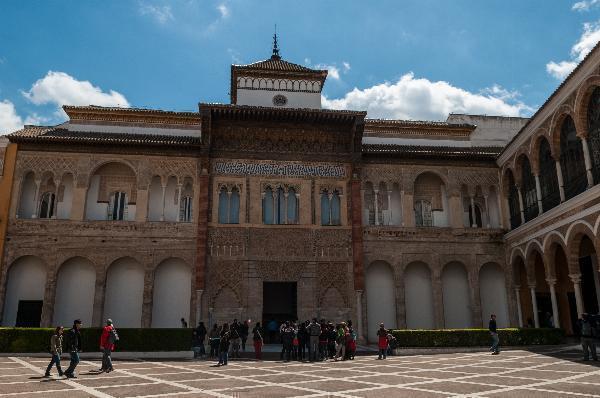Discovering Seville: 7 Historic Places You Must Explore

Strong 8k brings an ultra-HD IPTV experience to your living room and your pocket.
Seville, a city steeped in history and culture, offers a treasure trove of historic landmarks that beckon travelers from around the globe. From majestic palaces to ancient fortifications, each site reveals a chapter of Seville’s rich past. Among these, the Royal Alcázar of Seville stands as a testament to the city’s royal heritage and architectural prowess.
1. Royal Alcázar of Seville
Nestled in the heart of Seville, the Royal Alcázar of Seville is a masterpiece of Mudejar architecture. This UNESCO World Heritage site has served as a residence for numerous monarchs since the Middle Ages. The Alcázar’s intricate blend of Moorish and Christian influences reflects centuries of cultural exchange in Andalusia.
Attractions:
Patio de las Doncellas: A stunning courtyard adorned with intricate stucco work and reflecting pools.
Palacio de Pedro I: Known for its opulent Mudéjar ceilings and ornate plasterwork.
Gardens of the Alcázar: Lush gardens featuring ponds, fountains, and meticulously manicured hedges.
For an immersive experience, consider booking Royal Alcazar of Seville tickets in advance to avoid long queues and ensure access to this architectural gem.
2. Seville Cathedral
Adjacent to the Alcázar, the Seville Cathedral is the largest Gothic cathedral in the world and a pinnacle of Christian architecture. Built on the site of a former mosque, it boasts a towering Giralda bell tower offering panoramic views of the city.
Attractions:
La Giralda: A minaret converted into a bell tower, offering breathtaking views of Seville.
Capilla Mayor: Home to the tomb of Christopher Columbus and a splendid altarpiece.
Patio de los Naranjos: A tranquil courtyard filled with orange trees, remnants of the mosque's ablution area.
3. Plaza de España
Constructed for the Ibero-American Exposition of 1929, the Plaza de España is a sprawling plaza renowned for its blend of Renaissance Revival and Moorish Revival architectural styles. The semi-circular building features a series of bridges over a central canal, representing Spain's provinces.
Attractions:
Bridges and Canals: Explore the picturesque bridges adorned with colorful ceramic tiles depicting Spanish history.
Government Buildings: Currently housing government offices, these buildings offer a glimpse into early 20th-century Seville.
Moorish Influence: Intricate tile work and arches reminiscent of Moorish Spain add to the plaza's allure.
4. Barrio Santa Cruz
Seville’s historic Barrio Santa Cruz is a labyrinth of narrow streets, whitewashed houses, and hidden squares dating back to the city’s Jewish quarter. Wander through its charming alleys lined with orange trees and discover hidden plazas adorned with fountains and flowers.
Attractions:
Callejón del Agua: A picturesque alleyway known for its ancient water channels.
Plaza de los Venerables: Home to the Hospital de los Venerables, now a cultural center showcasing Baroque architecture.
Tapas Bars and Cafés: Sample traditional Andalusian cuisine at local tapas bars nestled within the neighborhood.
5. Metropol Parasol
Affectionately known as Las Setas (The Mushrooms), the Metropol Parasol is a modern architectural marvel in the heart of Seville’s old quarter. This wooden structure, designed by German architect Jürgen Mayer, offers panoramic views of the cityscape from its rooftop.
Attractions:
Archaeological Site: Beneath the structure, discover remnants of Roman and Moorish civilizations preserved in situ.
Market and Concert Venue: The Parasol’s base houses a bustling market and serves as a venue for concerts and cultural events.
Panoramic Terrace: Ascend to the rooftop for sweeping views of Seville’s skyline, including the Cathedral and Giralda.
6. Torre del Oro
Along the banks of the Guadalquivir River, the Torre del Oro (Tower of Gold) stands as a remnant of Seville’s Moorish fortifications. Originally built as a watchtower, it now houses a maritime museum detailing the city’s naval history.
Attractions:
Exhibitions: Explore maritime artifacts and models of historic ships inside the tower.
River Views: Climb to the top for views of the Guadalquivir River and the bustling port.
Historical Significance: Learn about the tower’s role in defending Seville during the Reconquista and subsequent centuries.
7. Hospital de los Venerables
Founded in the 17th century, the Hospital de los Venerables showcases Seville’s Baroque architecture and serves as a cultural center. Originally a retirement home for priests, it now hosts art exhibitions and concerts in its grand courtyard.
Attractions:
Baroque Architecture: Admire the intricate façade and interior adorned with frescoes and sculptures.
Art Exhibitions: Explore temporary exhibitions featuring works by local and international artists.
Courtyard and Gardens: Relax in the peaceful courtyard surrounded by orange trees and Baroque architecture.
Note: IndiBlogHub features both user-submitted and editorial content. We do not verify third-party contributions. Read our Disclaimer and Privacy Policyfor details.


